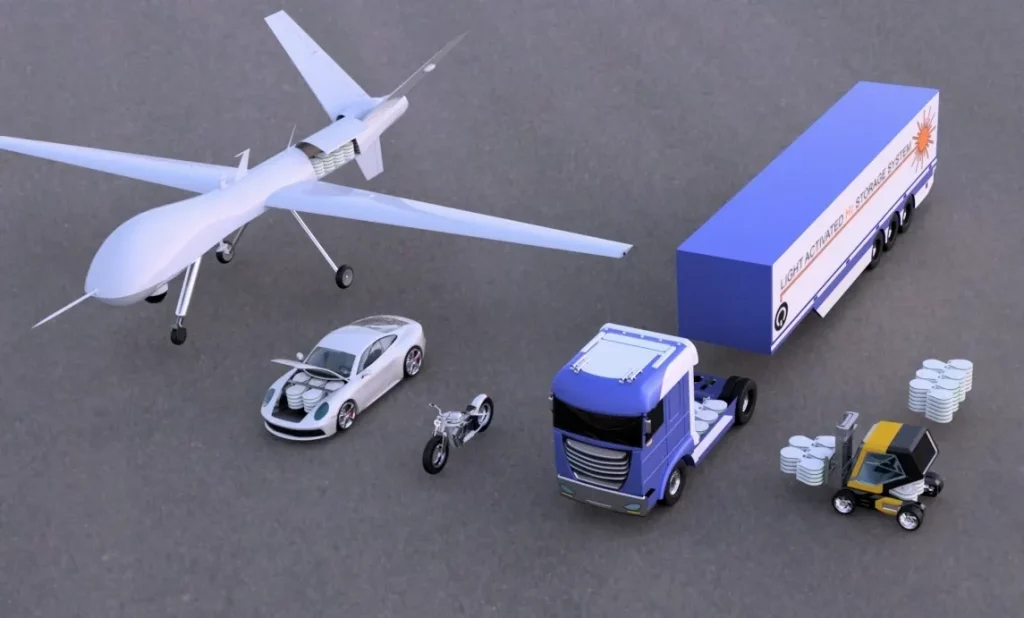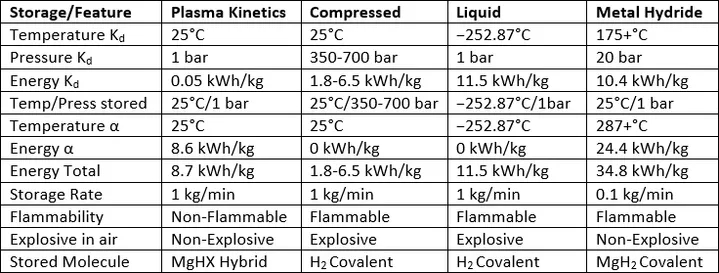
Hydrogen based storage technology could replace capacitor and battery technology for energy storage in vehicles, vessels and aircraft of various types and sizes. Previously, posts in this weblog have taken up a hydrogen station explosion, and its aftermath. In addition, a flawed report about the economics of hydrogen and methane has been examined.
Plasma Kinetics hydrogen technology was introduced, and patented, in 2008. It was first claimed that the technology was transformational, then disruptive. Almost immediately restrictions were placed on their use of patents, effectively resulting in the technology being banned by the US government. That situation continued until 2017, when it was allowed to be commercialized. There were some restrictions imposed under the International Traffic in Arms Regulations (ITAR), which continues to restrict its export as a missile fuel.
Where Plasma Kinetics technology differs from other providers of hydrogen, is that it does not need a compressed gas infrastructure to capture, move or distribute hydrogen. Instead, one common distribution method is to fill 19 l / 7 kg containers with hydrogen, for sale at assorted local stores. Empty containers can be returned, in exchange for recharged containers. The stored hydrogen is non-flammable. Containers of hydrogen can be transported via truck, rail, or ship without restriction. There is no need to build compressed hydrogen gas stations. Plasma Kinetics systems are slightly larger, and only moderately heavier, than compressed gas carbon-fiber tanks at 700 bar. But solid storage containers are much easier to manage than compressed gas, and have a lower overall energy cost, and a cleaner fabrication process. Safe, non-flammable, hydrogen storage in dense solid form. Hydrogen is zero-carbon. No energy or pressure is required to collect and store hydrogen. No pipelines or fixed structure pumping stations are required. Cassette, canister and other container systems can be easily recharged. Materials used are non-toxic and readily available worldwide. The entire processing process is quiet.
The nano-graphite film recharges through 150 cycles and is fully recyclable. The reason for this limit, is that the process only works with atomic hydrogen = 1H (where an atom consists of one proton and one electron, but no neutrons). This amounts to 99.98% of hydrogen found in the wild. Deuterium = 2H (where an atom consists of one proton, one neutron and one electron), amounts to 0.02% of the wild hydrogen population. It cannot be used in the energy system, so it accumulates on the film. It can, however, be retrieved when the storage units are recycled, and sold for a profit that exceeds the recycling costs!

My acquaintance with this technology came from a YouTube video (2021-06-24) on the E for Electric channel, when Sandy Munro was asked by Alex Guberman, what he would do if he became CEO of Toyota for a day? Part of his answer involved Toyota acquiring, or at least developing a relationship with, Plasma Kinetics.
Some weeks later, in an interview with Paul Smith (2021-08-12), Smith explains how the technology works, starting at about 5m00s in. He claimed that 15 lbs provides 20 miles of range in a car. With a severe allergy to imperial units, I would probably have said that a 19 l/ 7 kg cartridge would provide an average car with sufficient energy for 30 km. Cylinders for trucks would be 20 x larger (140 kg). Four of those would allow a truck to travel 570 miles = ca. 900 km.
One of the main concerns with this technology is the capability of consumers to replace a 19 l/ 7 kg cartridge every 30 km. People expect a modern electric vehicle (EV) to have a range of at least 300 km, which would require a vehicle to carry ten such units, at a weight of 70 kg. It was pointed out that systems were being developed for the automatic removal and insertion of disks (in cars), and presumably cylinders (in trucks and airplanes).
It was noted that while batteries are extremely efficient, the specific energy of hydrogen, expressed in terms of J/ kg, is three times that of a battery. Except, in some respects, one is comparing avocados with olives! The hydrogen needs to go through a fuel cell for its energy to be converted to electricity.
It should be noted that prior to the hydrogen ending up in some container, water = H2O has been converted in an electrolyzer resulting in hydrogen 2 parts H2 and oxygen 1 part O2. Please do not ask what happens to the oxygen!
Both fuel cells and electrolyzers are becoming smaller, lighter and more reliable. Electrolyzers can be stationed at local wind or photo-voltaic farms, wastewater treatment facilities, or other climate friendly sources.
It was also pointed out that a conventional compressed hydrogen refueling station can cost US$ 2.5 to 3 million. This contrasts with a station for Plasma Kinetics containers that costs about US$ 200 000.
A fuel cell vehicle using this technology should be far cheaper to make than a battery electric vehicle. Some items are eliminated, others are repurposed. For example, the battery cooling system becomes a fuel cell cooling system. Some components remain the same, such as the electric motors. In essence, a heavy battery is being replaced with a much lighter fuel cell and the Plasma Kinetics photo release system for hydrogen. This should give the vehicle improved range.
Paul Smith concludes that interest for the technology is stronger in Asia and Europe, and much less so in North America. A fab = fabrication facility = factory, to make the equipment costs about US$ 100 million.
In EV 2030 predictions, the challenges with fuel cells involve the energy costs of electolyzing hydrogen from water, which account for somewhere between 25% (DC) and 31% (AC) energy loses. Then, processing of hydrogen in the fuel cell costs another 50%. This means that the energy value available to the motors is somewhere between 36 – 38%. In contrast, the energy value available with a battery is about 77%.
Since my prophecy quotient is already used up, I will only speak of dreams. One of which is that dynamic charging along highways will meet much of the vehicular need for electricity, by 2050. Unfortunately, this is not supported by any evidence seen so far. Associated with this dream, is that the cost of dynamic charging technology will be less than that provided by hydrogen containers and fuel cells or equivalent battery based components, in vehicles. An agenda to this dream is that solid-state batteries will become the norm because of their increased specific energy and energy density, and durability. Any such batteries will generally be much smaller and reserved for last mile situations, something a 20 kWh battery would be able to supply.

